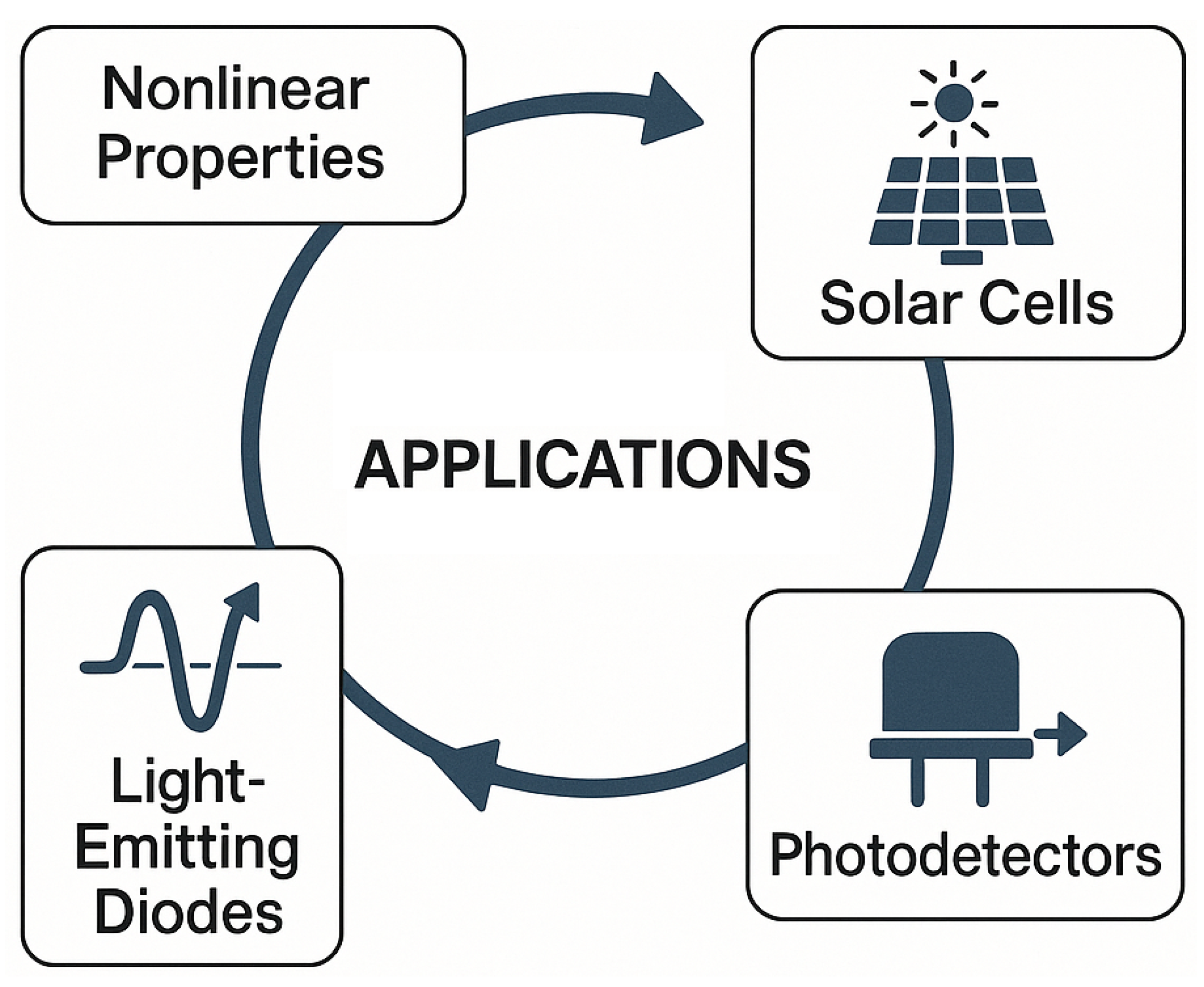Photonics Gets a Makeover: The New Era of Perovskite Devices
Funding
Acknowledgments
Conflicts of Interest
References
- Katz, E.A. Perovskite: Name Puzzle and German-Russian Odyssey of Discovery. Helv. Chim. Acta 2020, 103, e2000061. [Google Scholar] [CrossRef]
- Roberts, S. Dielectric and Piezoelectric Properties of Barium Titanate. Phys. Rev. 1947, 71, 890–895. [Google Scholar] [CrossRef]
- Stranks, S.; Snaith, H. Metal-halide perovskites for photovoltaic and light-emitting devices. Nat. Nanotechnol. 2015, 10, 391–402. [Google Scholar] [CrossRef] [PubMed]
- Sutherland, B.R.; Sargent, E.H. Perovskite photonic sources. Nat. Photonics 2016, 10, 295–302. [Google Scholar] [CrossRef]
- Diehl, R.; Brandt, G. Crystal structure refinement of YAlO3, a promising laser material. Mater. Res. Bull. 1975, 10, 85–90. [Google Scholar] [CrossRef]
- Mitzi, D.B.; Feild, C.A.; Harrison, W.T.A.; Guloy, A.M. Conducting tin halides with a layered organic-based perovskite structure. Nature 1994, 369, 467–469. [Google Scholar] [CrossRef]
- Birowosuto, M.D.; Dorenbos, P.; van Eijk, C.W.E.; Krämer, K.W.; Güdel, H.U. Scintillation and luminescence properties of Ce3+ doped ternary cesium rare-earth halides. Phys. Status Solidi A 2007, 204, 850–860. [Google Scholar] [CrossRef]
- Kishimoto, S.; Shibuya, K.; Nishikido, F.; Koshimizu, M.; Haruki, R.; Yoda, Y. Subnanosecond time-resolved x-ray measurements using an organic-inorganic perovskite scintillator. Appl. Phys. Lett. 2008, 93, 261901. [Google Scholar] [CrossRef]
- Zhang, L.; Luyao, M.; Wang, K.; Lv, Y.; Zhang, S.; Lian, Y.; Liu, X.K.; Ma, A.; Xiao, G.; Liu, Q.; et al. Advances in the Application of Perovskite Materials. Nanomicro Lett. 2023, 15, 177. [Google Scholar] [CrossRef] [PubMed]
- Rogalski, A.; Wang, F.; Wang, J.; Martyniuk, P.; Hu, W. The Perovskite Optoelectronic Devices—A Look at the Future. Small Methods 2025, 9, 2400709. [Google Scholar] [CrossRef] [PubMed]
- Kojima, A.; Teshima, K.; Shirai, Y.; Miyasaka, T. Organometal Halide Perovskites as Visible-Light Sensitizers for Photovoltaic Cells. J. Am. Chem. Soc. 2009, 131, 6050–6051. [Google Scholar] [CrossRef] [PubMed]
- Zhu, J.; Huang, X.; Luo, Y.; Jiao, W.; Xu, Y.; Wang, J.; Gao, Z.; Wei, K.; Ma, T.; You, J.; et al. Self-assembled hole-selective contact for efficient Sn-Pb perovskite solar cells and all-perovskite tandems. Nat. Commun. 2025, 16, 240. [Google Scholar] [CrossRef] [PubMed]
- Green, M.; Dunlop, E.; Yoshita, M.; Kopidakis, N.; Bothe, K.; Siefer, G.; Hao, X.; Jiang, J. Solar Cell Efficiency Tables (Version 66). Prog. Photovolt. Res. Appl. 2025, 33, 795–810. [Google Scholar] [CrossRef]
- Maulida, P.Y.D.; Hartati, S.; Firdaus, Y.; Hidayat, A.T.; Diguna, L.J.; Kowal, D.; Bruno, A.; Cortecchia, D.; Arramel, A.; Birowosuto, M.D. Recent developments in low-dimensional heterostructures of halide perovskites and metal chalcogenides as emergent materials: Fundamental, implementation, and outlook. Chem. Phys. Rev. 2024, 5, 011303. [Google Scholar] [CrossRef]
- Adjokatse, S.; Fang, H.H.; Loi, M.A. Broadly tunable metal halide perovskites for solid-state light-emission applications. Mater. Today 2017, 20, 413–424. [Google Scholar] [CrossRef]
- Kang, S.B.; Patil, P.; Yoon, G.W.; Han, G.S.; Jung, H.S.; Kim, D.H. Study of interface engineering on perovskite-based indoor photovoltaics for powering Internet-of-Things. Chem. Eng. J. 2024, 502, 157973. [Google Scholar] [CrossRef]
- Hardhienata, H.; Ramdhani, I.; Alatas, H.; Faci, S.; Birowosuto, M.D. Investigating the Photovoltaic Performance in ABO3 Structures via the Nonlinear Bond Model for an Arbitrary Incoming Light Polarization. Micromachines 2023, 14, 2063. [Google Scholar] [CrossRef] [PubMed]
- Kowal, D.; Chen, Y.; Birowosuto, M.D. Metal/Perovskite Plasmonic–Photonic Heterostructures for Active and Passive Detection Devices. Micromachines 2025, 16, 424. [Google Scholar] [CrossRef] [PubMed]
- Seyed-Talebi, S.M.; Mahmoudi, M.; Lee, C.H. A Comprehensive Study of CsSnI3-Based Perovskite Solar Cells with Different Hole Transporting Layers and Back Contacts. Micromachines 2023, 14, 1562. [Google Scholar] [CrossRef] [PubMed]
- Sun, Y.; Wang, J.; Liu, J.; Bao, H.; Xu, J.; Zhang, G.; Xiao, L.; Zhang, G.; Zhang, Z.; Qin, C.; et al. Buried Grating Enables Fast Response Self-Powered Polarization-Sensitive Perovskite Photodetectors for High-Speed Optical Communication and Polarization Imaging. Small 2025, 21, 2411610. [Google Scholar] [CrossRef] [PubMed]
- Wang, J.H.; Chen, B.C.; Chu, S.Y. The Fabrication and Characterization of Self-Powered P-I-N Perovskite Photodetectors Using Yttrium-Doped Cuprous Thiocyanate. Micromachines 2025, 16, 666. [Google Scholar] [CrossRef] [PubMed]
- Chen, C.; Zhu, Y.; Dou, K.; Liu, C.; Yu, C.; Ji, S.; Wang, J. Perovskite Light-Emitting Devices Based on Solid-State Diffusion In Situ Dynamic Thermal Crystallization. Micromachines 2023, 14, 2084. [Google Scholar] [CrossRef] [PubMed]
- Li, Y.; Gao, T.; He, Z.; Shen, C.; Zhou, S.; Li, M.; Zhang, D.; Zhang, Q.; Fu, Y.; Mo, X.; et al. Flexible perovskite light-emitting diodes: Recent progress, applications and challenges. npj Flex. Electron. 2025, 9, 32. [Google Scholar] [CrossRef]
- Shen, W.; Chen, J.; Wu, J.; Li, X.; Zeng, H. Nonlinear Optics in Lead Halide Perovskites: Mechanisms and Applications. ACS Photonics 2021, 8, 113–124. [Google Scholar] [CrossRef]
- Chen, W.; Zhang, F.; Wang, C.; Jia, M.; Zhao, X.; Liu, Z.; Ge, Y.; Zhang, Y.; Zhang, H. Nonlinear Photonics Using Low-Dimensional Metal-Halide Perovskites: Recent Advances and Future Challenges. Adv. Mater. 2021, 33, 2004446. [Google Scholar] [CrossRef] [PubMed]
- Wang, G.; Xing, G. 12—Perovskite nonlinear optical properties and photonics. In Metal Halide Perovskites for Generation, Manipulation and Detection of Light; Martínez-Pastor, J.P., Boix, P.P., Xing, G., Eds.; Photonic Materials and Applications; Elsevier: Amsterdam, The Netherlands, 2023; pp. 323–370. [Google Scholar] [CrossRef]

Disclaimer/Publisher’s Note: The statements, opinions and data contained in all publications are solely those of the individual author(s) and contributor(s) and not of MDPI and/or the editor(s). MDPI and/or the editor(s) disclaim responsibility for any injury to people or property resulting from any ideas, methods, instructions or products referred to in the content. |
© 2025 by the author. Licensee MDPI, Basel, Switzerland. This article is an open access article distributed under the terms and conditions of the Creative Commons Attribution (CC BY) license (https://creativecommons.org/licenses/by/4.0/).
Share and Cite
Birowosuto, M.D. Photonics Gets a Makeover: The New Era of Perovskite Devices. Micromachines 2025, 16, 832. https://doi.org/10.3390/mi16070832
Birowosuto MD. Photonics Gets a Makeover: The New Era of Perovskite Devices. Micromachines. 2025; 16(7):832. https://doi.org/10.3390/mi16070832
Chicago/Turabian StyleBirowosuto, Muhammad Danang. 2025. "Photonics Gets a Makeover: The New Era of Perovskite Devices" Micromachines 16, no. 7: 832. https://doi.org/10.3390/mi16070832
APA StyleBirowosuto, M. D. (2025). Photonics Gets a Makeover: The New Era of Perovskite Devices. Micromachines, 16(7), 832. https://doi.org/10.3390/mi16070832




